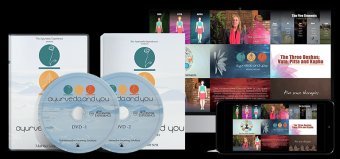
Ayurveda Introduction
 Watch the 10-minute video below for a brief introduction to the principles of Ayurveda…
Watch the 10-minute video below for a brief introduction to the principles of Ayurveda…
Ayurveda is a 5, 000-year-old system of natural healing that has its origins in the Vedic culture of India.
The word Ayurveda is from the Sanskrit language and composed of two parts:
“Ayus” means Life,
“Veda” means Knowledge, Wisdom, Science.
Thus the term meaning can be translated as a “Science/Wisdom of Life”.
More than a mere system of treating illness, this is a science of life (Ayur = life, Veda = science or knowledge). It offers a body of wisdom designed to help people stay vital while realizing their full human potential.
Providing guidelines on ideal daily and seasonal routines, diet, behavior and the proper use of our senses, Ayurveda reminds us that health is the balanced and dynamic integration between our environment, body, mind, and spirit.
Main Concepts
- Individualized approach to the person – each person has unique physical and psychic (mind-body) constitution. Recognizing that human beings are part of nature, Ayurveda describes three fundamental energies (dosha) that govern our inner and outer environments.
- This is an integral study, considering and using all aspects of the human being – gross physical body and subtle mental, emotional, and spiritual aspects.
- Personal responsibility and active deliberate participation of the individual in recovery and health maintenance.
- Methods are natural, understanding that besides gross components and actions there are subtle vital energies behind food, herbs, and other therapies that bring subtle, but significant effects and properties.
- It is cost-effective. As soon as you learn your own unique being and comprehend the concepts of Ayurveda you can use its methods to maintain the healthy balance though your whole life free of charge.
This “Science of Life” teaches us how to preserve health in wide sense and bring happiness and satisfaction in our lives.
Which tools does Ayurveda most rely on to restore balance and preserve health?
Appropriate changes in lifestyle, routines, diet, Ayurvedic herbs, exercises, meditation, and natural procedures like oil massage, and sweating are all used. Panchakarma and rasayana therapies are employed for deeper detoxification and rejuvenation.
Having a consultation with an Ayurvedic practitioner will help you recognize your current constitution (Prakruti) and current state of imbalance (Vikruti). You will understand the behavioral causes of current imbalances and get advice on how to change your lifestyle, diet, and herbs to restore balance.
Spiritual Background
The ancient seers of India perceived a dual principle behind existence: Spirit (Purusha) and Nature (Prakruti). The union of Spirit and Matter produces everything. Together they are consciousness and creativity.
From the coming together of these two forces a Cosmic Intelligence (Mahat) emerges, which contains within it the seeds and laws of nature. It also exists within the human being as intelligence (Buddhi), our capacity for perception, discernment, and the developing vehicle for enlightenment.














